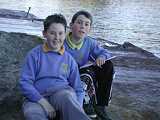Protocols for teachers undertaking Marine Investigations
These are a draft set of protocols for teachers undertaking marine investigations. It was developed by Ingrid Albion, Marine Pest Project Officer, from the Marine Discovery Centre,Woodbridge, Tasmania.
This is a working document please send us additions, corrections and information for your particular state or territory. |

Kids on a beach walk |
| |
|

Kids studying and enjoying the seashore |
- Ensure students have adequate weather safety gear and footwear
(Sneakers or blundstones are best for climbing on rocks. Bring sunhats, sun block, raincoats, etc)
- Teachers need first aid kit and preferably a first aid certificate and bronze medallion and be in occordance with their school's Occupational Health and Standards (OH&S) requirements.
|
- Do not poke your fingers into crevices etc. where you cannot see.
- Don't touch or pick up any octopuses of any color
- Be careful of animals with spines (eg fish) or spicules such as sponges.
- If you want to see an animal close up place it in a shallow container of seawater so that it does not dry out before you pass it around the group
- When looking under rocks always replace the rock back the way it was - it is a home to animals
- If you pick up any animals always place them back where you found them - in the same rockpool
- Be gentle with the creatures and rocks
- Don't pull seastars, sea urchins or molluscs off the rocks if they are stuck - leave them there.
If you want to take and possess certain fish (eg undersize) or other marine species for a marine aquarium in the classroom you will need :
· A permit issued under the Living Marine Resources Management Act 1995 to hold marine life in the classroom for educational purposes.
You may also obtain legal size fish through authorised commercial fishers. Should you obtain any fish from anyone, you need to ensure that they are authorised to take that particular species. It is recommended you maintain a register to record the fisher's details such as name, licence and date. Some people prefer to operate a register to record details of all fish including origin, size, health, mortality etc.
To apply for a permit you need to lodge an "application for a permit" form. These are available from Primary Industries, Water and Environment at the contacts below;
Internet: http://www.dpiwe.tas.gov.au/inter.nsf/FormPermits
Phone contacts:
Rob Green (6233 6208), Rod Pearn (6233 6099), or Sally Williams (6233 3119)
Fax: 6223 1539
Mail or in person:
Developmental Fisheries Section,
Marine Resources and Permits
Dept. Primary Industries Water & Environment
GPO Box 44
Hobart 7001
(Marine Board Building, 1 Franklin Wharf, Hobart)
The permit will be for a set time period and will limit you to certain species. Attached is a copy of a "standard school aquarium" permit. The numbers and species authorised are considered the maximum that can be justifiably taken from the wild for school aquariums. You should also note that these are the maximum numbers and you should only take what your aquarium and your aquarium supervisor can maintain!
Use the permit as a teaching tool to explain to students the need to look after our marine life and the reasons why we have permits:
- To protect the fishing industry and maintain viable fish populations and biodiversity we have limits on fish sizes and fish takes. Undersize fish are not yet breeding age. Have rulers or charts to demonstrate fish size limits (DPIWE currently has these rulers available throughFishcare).
- At certain times of the year some species are breeding so it is important not to collect these at those times. Find out from DPIWE when these times are. It's the teachers' responsibility if they wish to avoid action against them. This is particularly important in species that are under threat. Female crabs and crayfish should not be taken when they are carrying eggs. Check for this by looking under the telson or tail section of a crab.
Next - Organise a suitable aquarium |